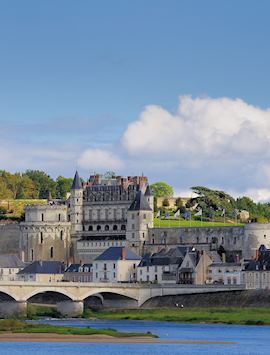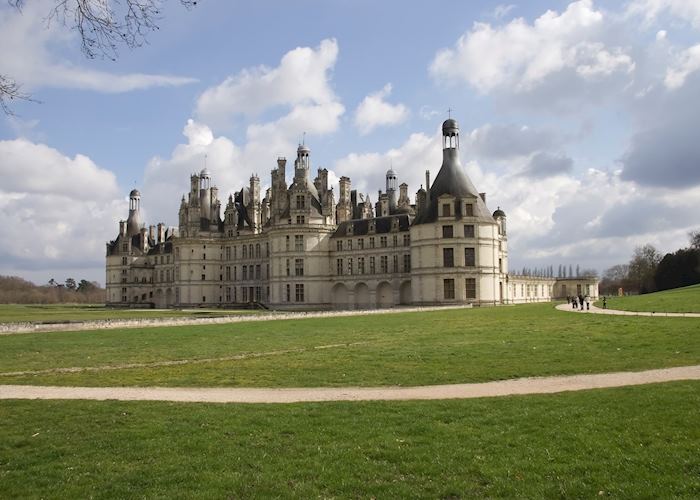Jump to:
An extravagant celebration of French Renaissance architecture, the Château de Chambord is the most ambitious of the Loire Valley palaces. It was intended as an almighty symbol of power, wealth and superiority, commissioned by French king François I as a hunting lodge but aimed at surpassing anything that his greatest rival, Emperor Charles V, could come up with.
Chambord is also an outrageous example of the extraordinary fortunes controlled by the French nobility. It very publicly fulfilled the king's desire to assert himself as the supreme leader of his era. In reality, though, he admitted that the chateau was almost uninhabitable and he spent a mere 42 days there during his entire reign.
France specialist LizOstentatious, overwrought, extravagant — Château de Chambord inspires superlatives. I love the way that its Disney-esque silhouette bristles with turrets, cupolas, chimneys and domes. Inside, the grand double-helix staircase is reputed to have been designed by da Vinci.
Things to see and do in Château de Chambord
Grand designs
 The Italian architect Domenico da Cortona was commissioned by François I in 1519 to design a chateau that would reflect the finest Renaissance art forms and surpass all others in the process. His design, with its harmonious style and symmetrical grace, is now regarded as the quintessential Loire Valley chateau and one of the greatest achievements of its time.
The Italian architect Domenico da Cortona was commissioned by François I in 1519 to design a chateau that would reflect the finest Renaissance art forms and surpass all others in the process. His design, with its harmonious style and symmetrical grace, is now regarded as the quintessential Loire Valley chateau and one of the greatest achievements of its time.
With more than 440 rooms, 85 staircases and 365 chimneys, it’s a gargantuan structure. Impossible to heat and too grand to feel homely, consecutive owners made attempts to make the palace more habitable, lowering ceilings in places, adding wooden paneling to dampen sounds and provide insulation, and creating smaller fireplaces within the massive originals.
Inside the chateau
You can see alterations made by Louis XIV and his son, the Comte de Chambord, in their apartments on the first floor. There are numerous other rooms on show, hung with tapestries and enormous oil paintings and still containing their original furniture. Perhaps the most spellbinding of all, though, is the Great Staircase, which sits at the heart of the donjon, the chateau keep.
The donjon is laid out in the form of a Greek cross with four main rooms. This layout was previously unheard of outside religious buildings and was intended as a symbol of the sacred status of the king. Between the rooms is the ornate staircase, possibly designed by Leonardo da Vinci, its double helix spirals winding organically and separately up to the Great Lantern Tower, which provides a bird's-eye view of the roof with its forest of chimneys, cupolas and turrets.
who's been there

Start planning your tailor-made trip to Château de Chambord by contacting one of our France specialists
-
617-223-4521617-223-4762
- Make an inquiry
Suggested itinerary featuring Château de Chambord
This sample itinerary will give you an idea of what is possible when you travel in Château de Chambord, and showcases routes we know work particularly well. Treat this as inspiration, because your trip will be created uniquely by one of our specialists.
Places near Château de Chambord
- Château de Cheverny 9 miles away
- Château de Chaumont-sur-Loire 19 miles away
- The Loire Valley 25 miles away
- Amboise 29 miles away
- Château de Chenonceau 29 miles away
- Château de Villandry 51 miles away
- Château d'Azay-le-Rideau 56 miles away
- Chinon 68 miles away
- Paris 95 miles away
- Normandy 108 miles away
- Rouen 128 miles away
- Honfleur 139 miles away
- Bayeux 154 miles away
- Mont Saint-Michel 157 miles away
- Burgundy 161 miles away
- Reims 162 miles away
- Dordogne 176 miles away
- Sarlat-la-Canéda 190 miles away
- Beynac-et-Cazenac 193 miles away
- La Roque-Gageac 194 miles away
- Arras 194 miles away
- Castelnaud-la-Chapelle 195 miles away
- Lyon 203 miles away
- Saint-Émilion 206 miles away
- Bordeaux 217 miles away
- Lille 220 miles away
- Annecy 248 miles away
- Rhône-Alpes 253 miles away
- Talloires 255 miles away
- Alsace 271 miles away
- Colmar 273 miles away
- Toulouse 278 miles away
- Chamonix 282 miles away
- Uzès 286 miles away
- Orange 288 miles away
- Pont-du-Gard 293 miles away
- Châteauneuf-du-Pape wine region 294 miles away
- Strasbourg 296 miles away
- Avignon 299 miles away









